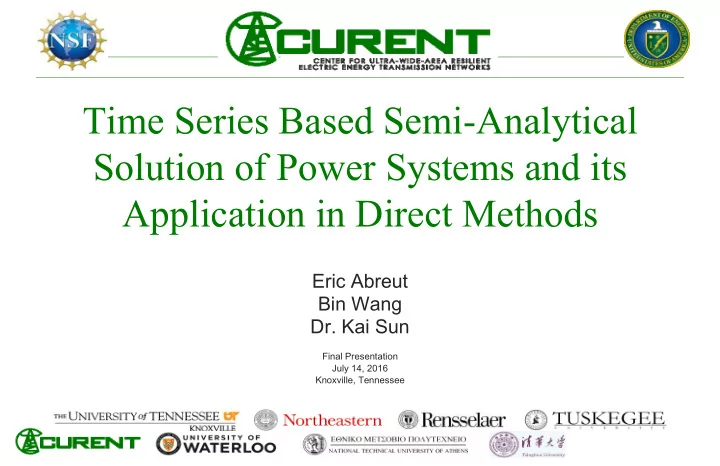

Time Series Based Semi-Analytical Solution of Power Systems and its Application in Direct Methods Eric Abreut Bin Wang Dr. Kai Sun Final Presentation July 14, 2016 Knoxville, Tennessee
Stability Problem 2
Time Domain Simulation vs. Direct Method Simulation • Time Domain Simulation: ◖ Numerical solution of the nonlinear differential algebraic equations. ◖ Time consuming. ◖ No information on the stability margin. • Direct Method Simulation: ◖ Evaluation of the predefined energy function for a power system. ◖ Almost Real-time. ◖ Stability margin is determined.
Traditional Direct Method Principle
Proposed Method • Traditional direct method includes fault-on time domain simulation (TDS). • Proposed method removes fault-on TDS and replaces with the fault-on symbolic semi-analytical solution. • This makes the method faster than real-time. 5
Why it is Useful • Help determine stability close to real time. • Provide explicit analytical solution. • Solution can replace Time Domain Simulation for short-time trajectory of system.
Formula and Steps Used Step 1: Where a 10 through a nm are unknown variables . Total number of unknowns are (m+1)*n.
Formula and Steps Used Step 2: Substitute assumed solution into given differential equations.
Formula and Steps Used Step 3: Equate the two sides of DE’s term by term for each equation:
Formula and Steps Used Step 4: Solve for the unknowns.
IEEE 9-bus System
Current Results This simulation is for a three-phase fault at BUS 7 for IEEE 9-BUS system. This figure is showing the fault-on trajectory of the system. - Blue Curve (under Red Curve) is from the time domain simulation. - Red Curve (above Blue Curve) is from the proposed method. - Results are accurate. 12
CCT = Fault Time Duration CCT = .231 CCT = .430 Error Index = .492 degrees Error Index = 19.936 degrees
ACCURACY TABLE
Decoupling Based Direct Method • Linear decoupling transformation. • Single machine infinite bus (SMIB) power systems as oscillation modes are constructed. • Transient energy function method is applied to each SMIB system. • Stability margins are calculated.
Small System Stability Margin and CCT Ranking Table
Large System Introduction • Fault-on Duration was set to .05 seconds for all cases. • If CCT > FDT then the system should be stable. • However, if CCT < FDT then the system should be unstable.
Large System Stability Margin and CCT Ranking Table
Large System Stability Margin and CCT Ranking Table
Next Steps Prepare and submit General Meeting paper by October.
Acknowledgements This work was supported primarily by the ERC Program of the National Science Foundation and DOE under NSF Award Number EEC-1041877. Other US government and industrial sponsors of CURENT research are also gratefully acknowledged.
Q&A Thanks! Any Questions?
Recommend
More recommend